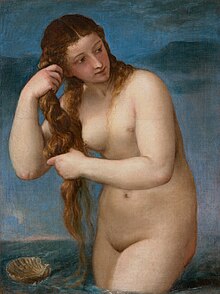Anadyomena


Anadyomene ( ancient Greek Ἀναδυομένη Anadyoméne [ / Anadyoménɛː / ], German 'the rising' ) was an epithet of the Greek goddess Aphrodite . The nickname referred to the legend handed down by Hesiod about the birth of Aphrodite, which is said to have emerged from the foam of the sea in Cyprus after blood and semen from the severed family of Uranos had mixed with the water of the sea.
The nickname Anadyomene came into use primarily through the famous (and often copied) painting of Apelles , in which she, just emerging from the sea, gracefully wringing the water out of her hair. The painting was created for the citizens of the island of Kos and hung there in the temple of Asclepius . On the orders of Augustus , the painting was brought to Rome. There it was consecrated as a portrait of the ancestor of the Julier family, his deified adoptive father Julius Caesar . The citizens of Kos were compensated with a tax rebate of 100 talents. At the time of Nero , the lower half of the now damaged picture was replaced by a copy by the painter Dorotheos . The upper half was restored at the time of Vespasian .
According to Pliny , Kampaspe , Alexander the Great's favorite concubine , was the model of the Anadyomene des Apelles. The painter would have fallen in love with Kampaspe, whereupon Alexander magnanimously left his concubine to the painter he loved. According to Athenaios, however, the even more famous Athenian hetaera Phryne is said to have been the model. The painter saw her at the Eleusis Festival when she went naked into the sea.
The goddess was occasionally mentioned under her surname in literature of the 20th century, for example in the poem entitled "Anadyomene" by the English writer John Fowles in his Apollo cycle from 1951–52. Fowles alluded to them again in his novel The Collector from 1963 (German The Collector ).
literature
- Otto Jessen : Anadyomene . In: Paulys Realencyclopadie der classischen Antiquity Science (RE). Volume I, 2, Stuttgart 1894, Col. 2019-2021.
Web links
Individual evidence
- ↑ Hesiod Theogony 188-206
- ^ Strabo Geography 14.2
- ^ Günther Bröker: Apelles 1 . In: General Artist Lexicon . The visual artists of all times and peoples (AKL). Volume 4, Seemann, Leipzig 1990, ISBN 3-598-22744-2 , p. 502 f.
- ↑ Pliny Naturalis historia 35:36
- ↑ Athenaios Deipnosophistai 13,590
- ^ John Fowles: Selected Poems . Ed .: Adam Thorpe. Flambard Press, Hexham / GB 2012, p. 26 .
- ↑ John Fowles: The Collector . Propylaea, Berlin 1964, p. 202 .